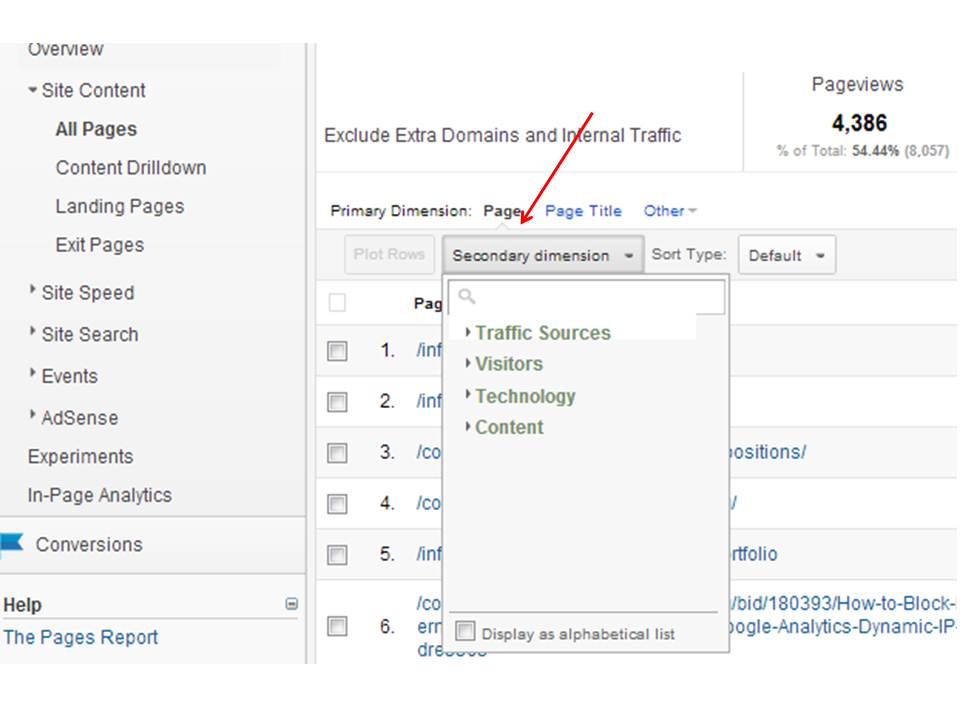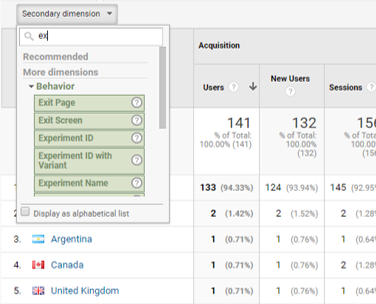Deciphering the Relevance of Secondary Dimension in Google Analytics: All Regarding Its Value and Effect
In the world of digital analytics, the use of second measurements within Google Analytics works as a critical device for critical much deeper layers of information understandings. The importance of secondary dimensions hinges on their capability to provide a nuanced sight of user behavior and communication with an internet site or platform. By dissecting data beyond surface-level metrics, companies can unlock a wealth of info that shapes calculated choices and improves advertising efforts. This expedition into the world of second measurements not just provides a thorough understanding of individual interaction but likewise drops light on the complex characteristics that drive on-line efficiency.
Comprehending Secondary Measurements in Google Analytics
The understanding of secondary measurements in Google Analytics is necessary for obtaining deeper understandings into individual behavior and internet site efficiency. While key measurements supply basic information factors such as traffic resources and web page views, additional dimensions allow for a more nuanced analysis by providing additional context to these key metrics. By incorporating second dimensions, users can sector and filter their information to reveal patterns and patterns that may not be instantly obvious.

Revealing the Perks of Secondary Dimensions
Building upon the foundational understanding of second dimensions in Google Analytics, checking out the advantages they supply reveals indispensable insights for enhancing data evaluation and decision-making. By integrating secondary measurements, users can dive deeper right into their data, getting an extra detailed sight of individual actions, material efficiency, and other crucial metrics. Among the key benefits is the ability to section data, enabling a much more granular evaluation of various measurements such as traffic sources, devices, demographics, and a lot more. When looking at information in accumulation., this segmentation enables individuals to determine patterns, fads, and correlations that might not be apparent (what is a “secondary dimension” in google analytics?).
Additionally, second measurements provide context to main data, providing extra layers of info that can help in recognizing customer interactions and preferences. This boosted understanding can guide calculated decision-making, bring about more targeted marketing campaigns, site optimizations, and general better performance. Basically, second measurements function as an effective tool for unlocking much deeper insights and making the most of the energy of Google Analytics for organizations and website owners.
Leveraging Additional Measurements for Boosted Insights
By using the power of additional dimensions in Google Analytics, organizations can reveal deeper insights that drive informed decision-making and strategic optimization initiatives. Leveraging additional measurements permits companies to delve past surface-level information and obtain a much more thorough understanding of customer actions, target market demographics, traffic sources, and website efficiency. As an example, by combining main dimensions like traffic sources with second dimensions such as geographic place or gadget category, services can recognize which gadgets or regions are driving one of the most valuable website traffic to their site.
Moreover, additional measurements make it possible for businesses to segment and analyze information better, aiding them determine patterns, patterns, and possibilities that might have or else gone unnoticed. By using secondary measurements, businesses can customize their advertising methods, material, and individual experience to much better fulfill the needs and preferences of their target audience. In essence, leveraging second measurements in Google Analytics equips businesses to make data-driven choices that cause enhanced performance, enhanced ROI, and lasting development.

Influence of Additional Dimensions on Data Analysis
Enhancing data analysis via the usage of secondary dimensions in Google Analytics offers businesses with a much deeper understanding of their on-line efficiency metrics. By integrating secondary measurements, such as time of day, geographical location, or device group, businesses can discover beneficial insights that might have been ignored with primary measurements alone. This improved level of granularity permits for even more exact segmentation of data, making it possible for services to determine patterns, patterns, and connections that can drive strategic decision-making.

Optimizing Potential: Secondary Dimensions Techniques
The tactical use of second dimensions in Google Analytics expands beyond improving information analysis; it includes crafting targeted strategies to open the full potential of beneficial insights for business growth. By utilizing second dimensions successfully, organizations can delve much deeper right into their site traffic, individual habits, and marketing projects to extract workable understandings. One essential technique is to incorporate secondary measurements with main measurements to acquire an extensive sight of individual interactions. For instance, matching the primary dimension of 'source/medium' with additional dimensions like 'landing page' or 'device group' can disclose which networks are driving web traffic to details pages or how user habits varies throughout gadgets.
In addition, utilizing second measurements to segment data based upon user demographics, actions, or modern technology can help businesses customize their marketing initiatives to particular target market sectors. This targeted approach can bring Recommended Site about boosted conversion rates, improved user experiences, and eventually, raised ROI. By taking full advantage of the potential of secondary dimensions in Google Analytics, organizations can make informed decisions, maximize their on the internet presence, and drive sustainable development.
Final Thought
In final thought, secondary measurements in Google Analytics play a crucial role in supplying deeper understandings and enhancing information evaluation. Incorporating secondary measurements into information evaluation techniques can lead to more educated decision-making and enhanced overall performance.
While key measurements supply essential data points such as traffic resources and page views, secondary measurements allow for an extra nuanced evaluation by offering added context to these key metrics. By combining primary measurements like web traffic resources with secondary dimensions such as geographic area weblink or device category, companies can identify which devices or areas are driving the most useful traffic to their internet site.
By incorporating additional dimensions, such as time of day, geographical place, or gadget group, services can discover important understandings that may have been forgotten with key measurements alone. One crucial approach is to incorporate secondary dimensions with primary dimensions to get an extensive view of customer communications. Combining the primary measurement of 'source/medium' with second dimensions like 'touchdown page' or 'tool category' can reveal which networks are driving website traffic to particular pages or exactly how user behavior varies throughout gadgets.
Comments on “Described: The Duty and Interpretation of a 'Secondary Dimension' in Google Analytics”